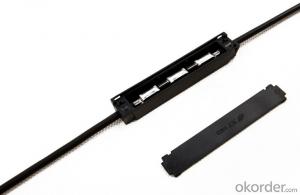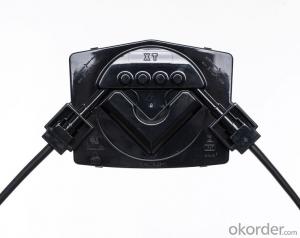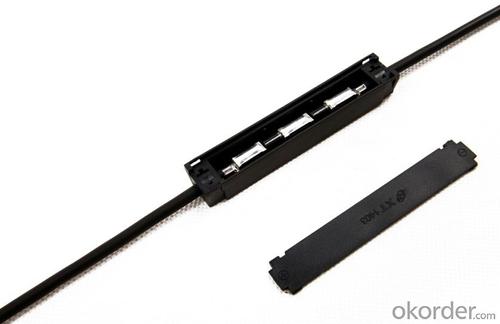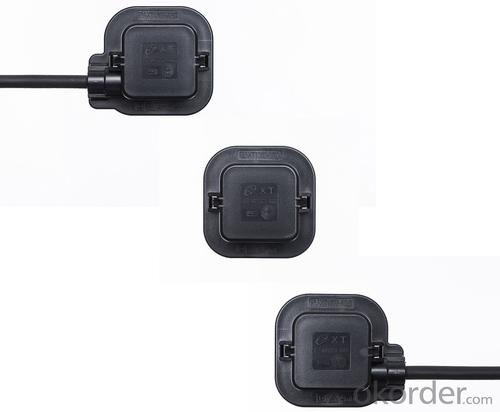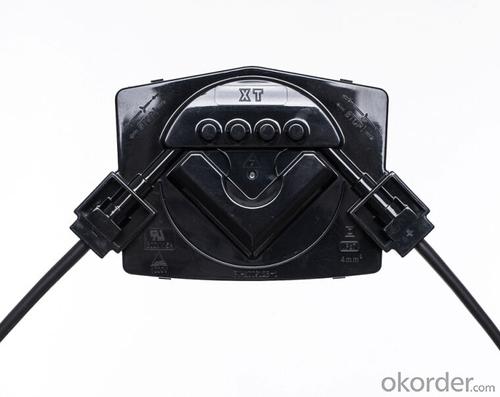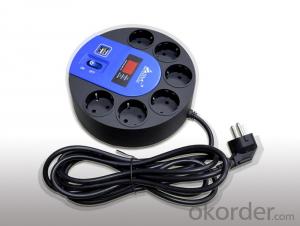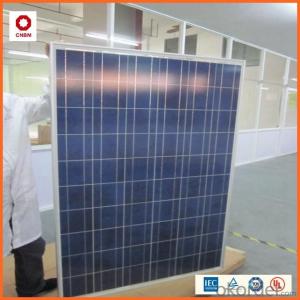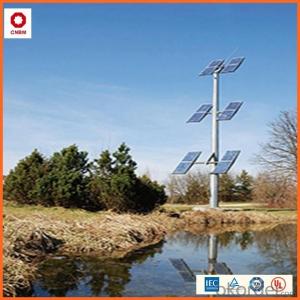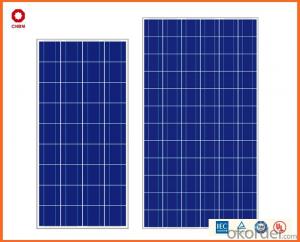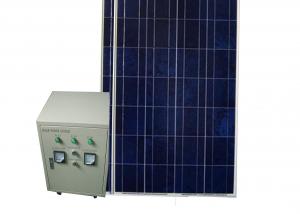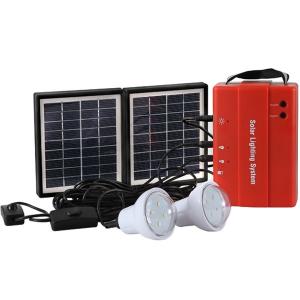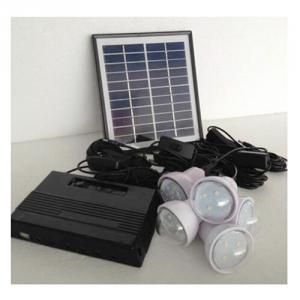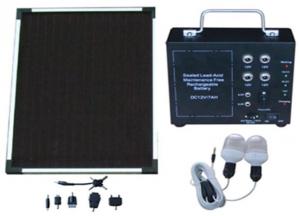Solar Energy Systems Dumfries PV Junction Box XT04 TUV, UL, ISO9001 Certification
- Loading Port:
- Guangzhou
- Payment Terms:
- TT OR LC
- Min Order Qty:
- 3000 pc
- Supply Capability:
- 3000000 pc/month
OKorder Service Pledge
OKorder Financial Service
You Might Also Like
Feature
a. leading Technology
b.long usable
c. securable and reliable Structure
d. simple Operation and easy Installation
e. low contact Resistance
f.good electric Protection
Product description
1. All the connection made by double fixed connection low power loss
2. With the capacity of anti-aging and resistance to ultraviolet radiation on the outer cover with excellent box design with good thermal dissipation
3. Demonstrating safe, realiable and excellent lasting functionality, applicable in harsh outdoors working ambient
4. Big variety for choices,1 rail ,2 rail,3 rail,4 rail,5 rail,6 rail.mini junction box and solar junction box for solar street light

Item | Data |
Terminals for Ribbons | 3/4 |
Rated Current | 7A |
Rated Voltage | 1000V |
Dimension | 119*81.3*21.6mm |
Temperature | -40℃~+85℃ |
Size of Cables | 4 mm2/12AWG |
Size of Ribbons | W(6±2mm)*T(0.3±0.15mm) |
Protection Degree | IP65 |
Flammability Class | V-0 |
FAQ
1. How long will my inquiry get response?
Your inquiry related to our products or prices will be replied within 24 hours.
2. Can I get professional service and suggestion?
Well-trained and experienced staffs to answer all your questions in fluent English.
3. Do you accept OEM or customized design?
OEM & ODM, any your customized lightings we can help you to design and put into product.
4. What if I need specific design?
Distributorship are offered for your unique design and some our current models.
- Q: What is the impact of solar energy systems on reducing energy poverty?
- The provision of affordable and sustainable electricity to communities lacking reliable access to traditional power grids is significantly impacted by solar energy systems. One of the primary benefits of such systems is their ability to generate electricity from sunlight, which is abundant in many parts of the world. This allows for the installation of solar energy systems even in remote and underserved areas, thereby reducing dependence on expensive and polluting fossil fuels. Solar energy systems harness the power of the sun to bring electricity to rural households, schools, and healthcare facilities that previously relied on costly and unreliable alternatives like kerosene lamps or diesel generators. This not only improves the quality of life for individuals and communities but also facilitates economic development by granting access to modern technologies and opportunities. Additionally, solar energy systems contribute to the reduction of energy poverty through the provision of a stable and dependable energy source. Due to their minimal maintenance requirements and long lifespan, solar panels can continue generating electricity for many years, minimizing the risk of power outages and ensuring a consistent energy supply. Furthermore, solar energy systems empower communities by enabling them to become energy-independent and self-sufficient. By installing solar panels on rooftops or utilizing solar-powered mini-grids, communities can generate their own electricity and decrease reliance on centralized energy systems. This not only enhances energy security but also creates income-generating opportunities through the sale of excess electricity back to the grid. In conclusion, solar energy systems play a vital role in reducing energy poverty by providing affordable and sustainable electricity to underserved communities. They enhance quality of life, foster economic development, and empower communities to become self-reliant. By leveraging the abundant and renewable energy of the sun, solar energy systems have the potential to transform the lives of millions of people and alleviate energy poverty on a global scale.
- Q: How do solar energy systems impact the overall energy independence of a building?
- Solar energy systems can significantly increase the overall energy independence of a building. By harnessing the power of the sun, these systems generate clean and renewable electricity, reducing the reliance on traditional energy sources. With solar panels installed, buildings can produce their own energy, thereby decreasing dependence on the grid and potentially eliminating or significantly reducing electricity bills. This not only helps in achieving energy self-sufficiency but also contributes to a more sustainable and environmentally-friendly future.
- Q: Are there any financing options available for purchasing solar energy systems?
- Yes, there are several financing options available for purchasing solar energy systems. These include solar loans, leases, power purchase agreements (PPAs), and government incentives such as tax credits and grants. These options aim to make solar energy more affordable and accessible for individuals and businesses.
- Q: Can solar energy systems be used in areas with high levels of snowfall?
- Solar energy systems can indeed be utilized in regions with abundant snowfall. Though snow can diminish the amount of sunlight reaching the panels, it does not render them entirely ineffective. Contemporary solar panels are engineered to function efficiently in various weather conditions, including snowy ones. Furthermore, the inclination and tilt of the panels can be adjusted to discard snow and maximize sun absorption. In snowy areas, it is customary to install solar panels at steeper angles to facilitate snow removal. Additionally, advancements in solar technology, such as the application of anti-reflective coatings and self-cleaning mechanisms, aid in preventing snow accumulation and maintaining optimal performance. It is important to note that while snow may temporarily decrease energy generation, solar energy systems can still generate electricity even in overcast conditions. In conclusion, with careful planning and upkeep, solar energy systems can be effectively employed in regions with substantial snowfall.
- Q: What is the impact of electromagnetic interference on the performance of solar panels?
- Electromagnetic interference can have a negative impact on the performance of solar panels. It can disrupt the proper functioning of the panels, causing fluctuations in the power output and reducing the efficiency of the system. This interference can be caused by nearby electronic devices or power lines, and can lead to decreased energy production and potential damage to the panels. Implementing appropriate shielding and mitigation techniques is crucial to minimize the impact of electromagnetic interference on the performance and longevity of solar panels.
- Q: Are solar energy systems noisy?
- No, solar energy systems are not noisy. They operate silently as they convert sunlight into electricity without any moving parts or mechanical components.
- Q: Can a solar energy system withstand extreme weather conditions?
- Certainly, extreme weather conditions pose no challenge for a solar energy system. Solar panels boast a sturdy design that enables them to endure diverse weather phenomena, such as scorching heat, freezing cold, fierce winds, heavy downpours, and even snowfall. These panels are crafted with tempered glass and often undergo rigorous testing to ensure their resilience against hailstorms or excessive snow loads. Moreover, solar panels are securely installed to withstand powerful gusts and are engineered to resist corrosion. In essence, although extreme weather conditions may slightly affect solar energy production, solar energy systems are purposefully constructed to persist and function optimally in various weather conditions.
- Q: Can solar energy systems be installed in areas with extreme weather conditions?
- Yes, solar energy systems can be installed in areas with extreme weather conditions. While extreme weather conditions such as extreme heat, cold, wind, or snow can potentially affect the performance of solar energy systems, modern solar technology has been designed to withstand these conditions. Solar panels are made from durable materials that can handle high temperatures, freezing temperatures, and strong winds. Additionally, solar panels are often tested and certified to meet specific industry standards for durability and performance in different weather conditions. In areas with extreme heat, solar panels are designed to dissipate heat and maintain their efficiency. They are also tested to ensure that they can withstand the high temperatures without any damage or significant loss in performance. In areas with extreme cold, solar panels are built to withstand freezing temperatures and can even generate electricity in snowy conditions. Some solar panels are designed with anti-reflective coatings to absorb more sunlight and melt snow faster. Furthermore, solar energy systems are often installed with proper mounting systems and structures that can withstand strong winds or storms. These systems are engineered to ensure that the solar panels remain securely attached to roofs or ground mounts even in areas prone to hurricanes or high winds. While extreme weather conditions can impact the performance of solar energy systems to some extent, with proper installation and design, solar panels can still generate electricity and provide a reliable source of renewable energy in areas with extreme weather conditions. It is important to consult with experienced solar installers or engineers who can assess the specific weather conditions of an area and design a solar energy system that can withstand those conditions.
- Q: Can solar energy systems be installed on sports facilities or stadiums?
- Yes, solar energy systems can be installed on sports facilities or stadiums. In fact, many sports facilities around the world have already installed solar panels to generate clean and renewable energy. This not only helps in reducing their carbon footprint but also saves them on energy costs in the long run. Solar energy systems can be easily integrated into the design of sports facilities or stadiums, making it a viable and sustainable option for powering these large-scale venues.
- Q: Can solar energy be used for heating?
- Yes, solar energy can be used for heating. Solar thermal systems can collect and convert sunlight into heat energy, which can then be used for heating water, homes, or other applications.
Send your message to us
Solar Energy Systems Dumfries PV Junction Box XT04 TUV, UL, ISO9001 Certification
- Loading Port:
- Guangzhou
- Payment Terms:
- TT OR LC
- Min Order Qty:
- 3000 pc
- Supply Capability:
- 3000000 pc/month
OKorder Service Pledge
OKorder Financial Service
Similar products
Hot products
Hot Searches
Related keywords
